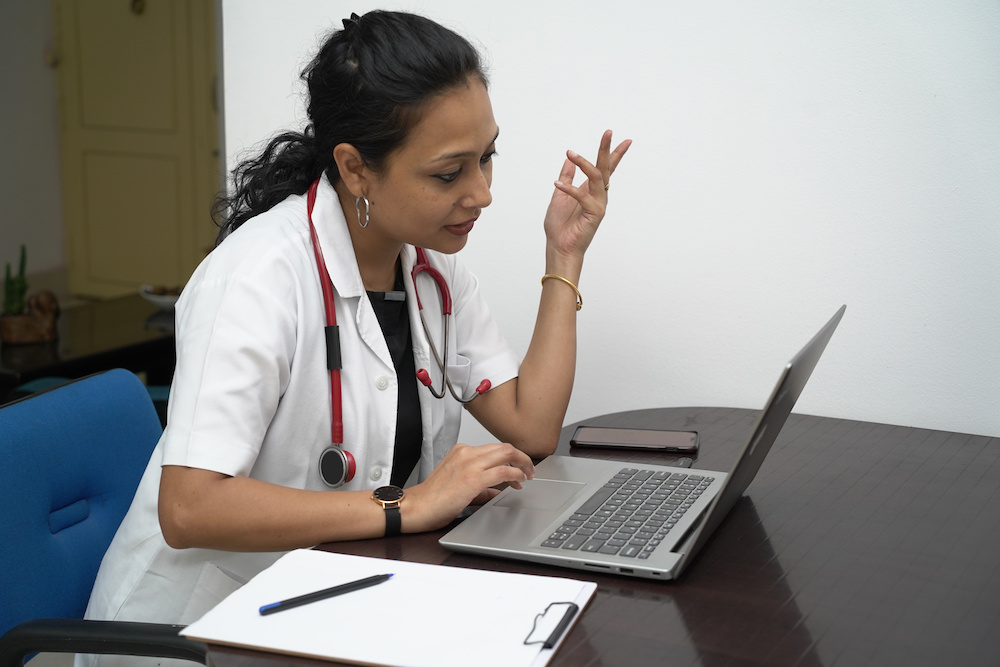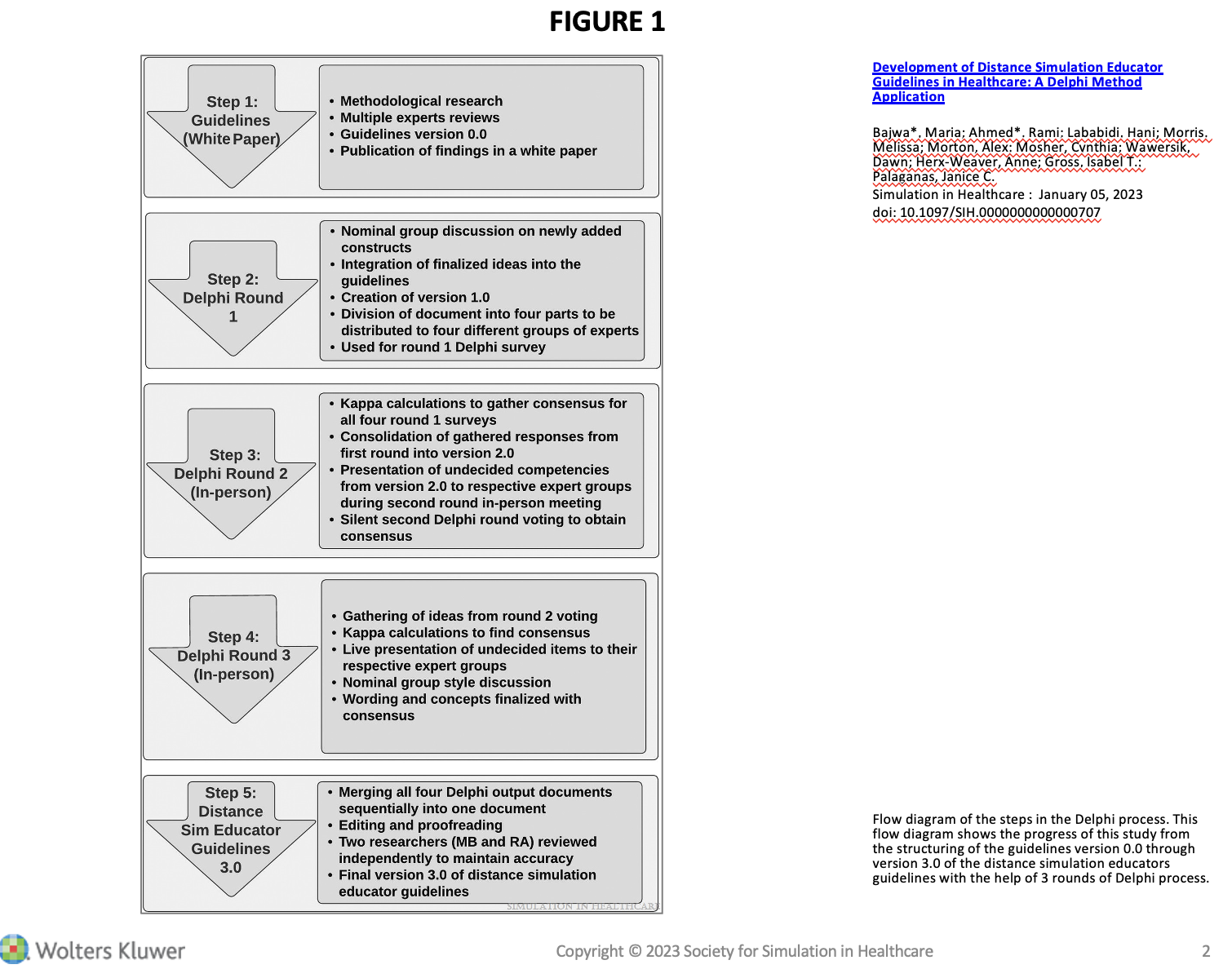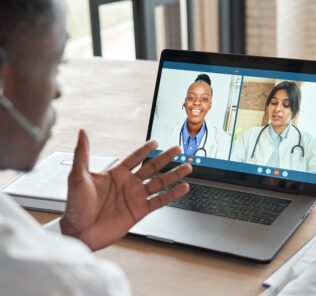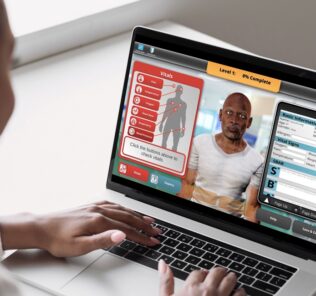Publication of Distance Simulation Educator Guidelines in Healthcare
Since 2020, many healthcare simulation centers have become familiar with the term “distance simulation.” The ability to provide distance simulation instruction is one factor that separated those healthcare simulation centers that were able to continue instruction during COVID-19 from those that were not. As a result of increased reliance on distance simulation, healthcare simulation leaders from across the industry gathered insights and sought to put together a set of distance simulation educator guidelines. In January 2023, the research titled “Development of Distance Simulation Educator Guidelines in Healthcare” was officially published in Simulation in Healthcare: The Journal of the Society for Simulation in Healthcare. This HealthySimulation.com article shares highlights from this research and explains how takeaways can be used by medical simulation educators worldwide.
First, the findings noted that distance simulation encompasses the modalities of distance, tele, remote, and extended realities (XR), including virtual reality, mixed and augmented reality, digital real-time gamification (but not 2-dimensional screen-based simulations), and any hybrid form of these simulations under the term “distance simulation.”
The authors sought to answer the following questions: (1) What are the basic competencies needed of a simulation educator who conducts simulation at a distance? (2) How do they differ from competencies identified for in-person simulation educators? (3) How can the basic competencies evolve into advanced competencies? And (4) How do advanced competencies compare with basic competencies?
Sponsored Content:
To answer these questions, the authors divided these guidelines into two levels of competency: the basic or competent level, which every distance sim educator should aim to possess when executing any distance simulation activities, and the advanced or expert level, which a distance sim educator may strive for in the future with continuous professional development.
Next, a rigorous design, thorough research, and knowledge synthesis led to the development of these guidelines. Using a well-respected agreement-seeking methodology, the Delphi method was used to analyze these guidelines. Several competencies were refined, reworded, or even deleted after discussion during the Delphi rounds leading to the third version of the Distance Simulation Educator Guidelines, version 3.0, or The DSEG for short. The DSEG has 59 competencies, 196 basic sub-competencies, and 182 advanced sub-competencies.
Key findings led to the publication of the following competencies:
Sponsored Content:
Domain 1: Professional Values and Capabilities: The experts finalized 13 competencies with sub-competencies for basic and advanced-level educators. A newer competency was the champions in distance simulation (competency number 1, comp #1), encompassing overall professional values for both basic and advanced-level distance simulation educators. We also added two crucial competencies: professional development (comp #12) and diversity, inclusion, and equity (comp #13), into the first domain to bring attention to these significant aspects of optimal professional environments. The experts helped refine the concept of diversity and inclusion according to the changing landscape of the learning environment in the light of social justice and equity issues faced by the participants of the distance learning environment.
Domain 2: Health Care and Distance Simulation Knowledge and Principles: 11 health care and distance simulation knowledge-based competencies were finalized in this domain. The competency of human factors (comp #23), added initially after an extensive literature search and expert input, was thoroughly analyzed during the second and third phases of the Delphi, leaving a generic description as a future research avenue because this construct is still developing as it relates to distance simulation. The competency of modeling was deleted in the final guidelines version 3.0. It was left for future researchers because the experts felt unqualified to write this competency without knowing the depth and breadth of modeling in the realm of distance simulation.
Domain 3: Educational Principles Applied to Distance Simulation: There are 26 competencies consisting of the basics of the simulation process and phases. The competencies of interprofessional education (comp #50) and debriefing (comp #43 & #46) in the distance simulation environments were elaborated. The evaluation and assessment of the activity and participants (comp #30, #41, & #47) have dedicated competencies and sub-competencies to improve the process and learning. After consensus, the principle of ethics (comp #5), originally in the third domain of the original CHSE blueprints, was moved into the first domain of “Professional Values and Capabilities” with its basic and advanced-level competencies in distance simulation environments.
Domain 4: Distance Simulation Resources and Environments: This domain was significantly modified and has nine competencies focused on technology, considering its fundamental role in distance simulation. Identifying and employing appropriate technologies (comp #51), establishing relationships with technology stakeholders (comp #53), and acquiring multimedia skills (comp #54) were some of the competencies from the original CHSE blueprints; however, they were expanded on in the light of distance simulation technologies and environments. The competency to work with standardized participants (SPs) in the distance simulation (comp #52) environment and telesimulation were combined after expert consensus. The SP competency was added into this domain considering the fact this instructional method was quite prevalent during the pandemic; it was felt that SP methodology was within reach of the average simulation program with low resources as being less costly than other forms of distance simulation warranting its own place.
The researchers anticipate that these guidelines will pave the way to provide standardized and equitable knowledge, training, and education to those using the distance simulation modality to reach learning outcomes safely and reliably, along with opening up multiple research avenues.
The DSEG Development: An Example of Collaboration
This ground-breaking research is the prime example of collaboration among multiple researchers, reputable organizations, and prestigious institutes, all following the common urgent need to have guidelines for simulationists while using distance simulation.
Professional development for distance simulation was the focus of Dr. Maria Bajwa’s Ph.D. scholarly work under the mentorship of Drs. Janice Palaganas and Rami Ahmed. Due to the enormous scope of research work and overlapping interests with different aspects of the content, other Ph.D. student scholars of the healthcare simulation track at the MGH Institute of Health Professions (MGH-IHP) participated in the guidelines synthesis. The initial work was done under the famous course HE 951, where Dr. Bajwa led six other Ph.D. students on a scholarship journey under the watchful eyes of her mentors, Drs. Ahmed and Palaganas. These students affectionately call themselves the Seven Simulation Stars of the MGH-IHP since this was the first cohort of this prestigious institute doing a doctoral degree focused on healthcare simulation, the first of its kind in the United States.
The Distance Simulation Collaboration, an international simulation organization, was established under the leadership of Dr. Janice Palaganas and Dr. Isabel T. Gross during the early pandemic days to respond to the challenges for healthcare simulation communities around the globe. Most of the Delphi study participants were members of the Distance Simulation Collaboration, along with some participants from the Fellows of the Society of Simulation in Healthcare (SSH), a leading global society promoting healthcare simulation. The SSH also provided a venue to hold the final steps of this study during their annual meeting, IMSH 2022, where national and international simulation scholars and researchers met and discussed these guidelines in a six-hour-long session. The Seven Simulation Stars of the MGH-IHP included Drs. Maria Bajwa, Hani Lababidi, Melissa Morris, Cynthia Mosher, Dawn Wawersik, Alex Morton, and Anne Herx-Weaver.
“There is so much we still do not know about distance simulation, yet it has the potential to truly leverage all the positive aspects of simulation and connect the world of immersive training in a way never thought possible. The potential for scholars and content experts to have the ability to instantly disseminate their knowledge and expertise to learners involved in immersive simulation training is very exciting,” expressed Ahmed.
Read the Distance Simulation Educator Guidelines
Lance Baily, BA, EMT-B, is the Founder & CEO of HealthySimulation.com, which he started while serving as the Director of the Nevada System of Higher Education’s Clinical Simulation Center of Las Vegas back in 2010. Lance is also the Founder and acting Advisor to the Board of SimGHOSTS.org, the world’s only non-profit organization dedicated to supporting professionals operating healthcare simulation technologies. His co-edited Book: “Comprehensive Healthcare Simulation: Operations, Technology, and Innovative Practice” is cited as a key source for professional certification in the industry. Lance’s background also includes serving as a Simulation Technology Specialist for the LA Community College District, EMS fire fighting, Hollywood movie production, rescue diving, and global travel. He and his wife Abigail Baily, PhD live in Las Vegas, Nevada with their two amazing daughters.
Sponsored Content:






















